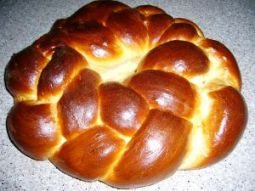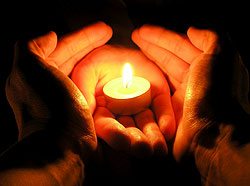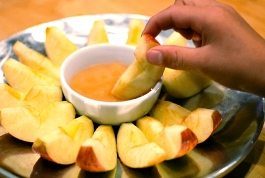In September, we celebrate the festival of Michaelmas, with Michael the archangel and his expulsion of Lucifer from Heaven. We often tell the story of St. George slaying the dragon and saving Princess Una and the rest of the village, for St. George is the earthly representation of Michael.
On the blog this month, we chose to focus on Michaelmas and slaying or taming our own internal dragons. Michaelmas is a holiday that is often celebrated in LifeWays and Waldorf circles, and it is also important to bring light to the high holidays of the Jewish faith that are celebrated in September: Rosh Hashanah and Yom Kippur.
One of the basic LifeWays practices stated on the LifeWays North America webpage is that “festivals and celebrations honoring traditional seasonal festivals, cultural backgrounds of families, and children’s birthdays are offered.” It is important to honor these holidays that live with us and find a meaningful and respectful relationship to the celebrations and holidays of the families of the children in our care.
Having been raised Catholic and now doing my own thorough and exhaustive search to find a faith or faiths where our family fits, I jumped at the opportunity to learn more about the Jewish faith through a glimpse of these two high holidays. Graciously, Maya Levanon, a mother of two children who previously attended the LifeWays Center in Milwaukee and a strong supporter of LifeWays, offered to help me for she is a practicing Jew. We had the lovely opportunity to meet during my first week of LifeWays training and she is eager to help in any way when it comes to furthering the LifeWays practices and principles, and sharing her knowledge and love of her faith.
At sunset on Sunday, September 16th, the first day of the Hebrew month of Tishrei, which is the first month of the Hebrew Year, Rosh Hashanah begins. It ends at sunset on Tuesday. Rosh Hashanah is the Jewish New Year and one of Judaism’s holiest days. It literally means “head of the year” and commemorates the creation of the world. The belief is that this is the celebration of the birth of Adam, of the first man created, so it is a new year for humanity. When Maya shared with me that Rosh Hashanah is a celebration of a new year for humanity, I immediately understood then how we can embrace this holiday for all families, regardless of culture or faith.
For some Jewish families, Rosh Hashanah is celebrated at sunset by lighting candles, praying and having a festive meal with many symbolic foods. Sharing Challah (braided baked bread formed in a circle to symbolize either the cyclical nature of life or the crown of God) and/or apples dipped in honey symbolizes the beginning of a sweet year. Eating fish or lamb heads symbolizes that the adults want to be leaders (“heads”) rather than “tails.”
meal with many symbolic foods. Sharing Challah (braided baked bread formed in a circle to symbolize either the cyclical nature of life or the crown of God) and/or apples dipped in honey symbolizes the beginning of a sweet year. Eating fish or lamb heads symbolizes that the adults want to be leaders (“heads”) rather than “tails.”
For Maya’s family and many other Jewish families, the following morning brings a trip to Synagogue for a morning of prayers. The Chazan (cantor) blows the Shofar (a ram horn) in a series of symbolic ritualistic sounds that are meant to open the sky, the heavens if you wish, so God can begin to hear the prayers in the days to come until Yom Kipur (10 days later). After lunch, families go to a water source to practice Tashlich. For Maya’s family, they symbolically turn their pockets inside out to represent throwing out sins and bad deeds. Other families throw bread crumbs into the water to represent the same. The water and practices wash away their sins and renew their spirits.
They spend the rest of the day dedicating time and energy to prayers and family meals. Eating a new fruit that hadn’t yet been consumed that year and wearing new clothes, while saying a blessing of thanks for being alive and having a chance at a new year are traditional ways to celebrate. The belief is that whatever is done during Rosh Hashanah is a sign of how the coming year will look and be.
 Many of the rituals that those of Jewish faith celebrate on Rosh Hashanah can be simply and beautifully incorporated within LifeWays inspired homes and centers. If you find yourself caring for, or even simply friends with, a child and his/her family of Jewish faith, there are ways to include some practices. For instance, sharing a meal of challah, apples and honey, and other foods, saying a blessing of thanks for the year past and the year to come, and throwing bread crumbs into a small pool of water can all be done with young children and done without overstepping boundaries of other families’ religious and cultural beliefs.
Many of the rituals that those of Jewish faith celebrate on Rosh Hashanah can be simply and beautifully incorporated within LifeWays inspired homes and centers. If you find yourself caring for, or even simply friends with, a child and his/her family of Jewish faith, there are ways to include some practices. For instance, sharing a meal of challah, apples and honey, and other foods, saying a blessing of thanks for the year past and the year to come, and throwing bread crumbs into a small pool of water can all be done with young children and done without overstepping boundaries of other families’ religious and cultural beliefs.
After Rosh Hashanah has passed, 10 days of “redemption” begin, during which each person of Jewish faith is doing deep reflection and asking for forgiveness from those they have wronged. On the eve of Yom Kippur, prior to sunset, Jews gather to share a pre-fast feast in order to gather strength for the 25-hour fast they are about to undertake.
On Wednesday, September 26th, Jews celebrate Yom Kippur. This is a day of atonement, which includes no eating, drinking, showering or pleasure of any sort for those over the age of thirteen. Work is also forbidden for Yom Kippur is the highest holiday of the Jewish faith. Traditionally, people wear all white to symbolize being angels – pure beings – for one day. It is believed that on this day, God decides each person’s fate, so Jews are encouraged to make amends and ask for forgiveness for sins committed during the past year. In the days leading up to Yom Kippur, many Jewish families also give to charity or donate time as a way to show God they are making amends. At sunset, a break-the-fast meal is shared.
 While many of the practices performed on Yom Kippur are intended for adults, there are still ways to bring Yom Kippur into our daily life and care for children and families. We can share a break-the-fast meal, light a candle, say a blessing together. Personal reflection is an important habit for the adult. Also, Maya mentioned having the young children dress in all white, just as the adults do. They make quite adorable little angels, since they are so pure and innocent.
While many of the practices performed on Yom Kippur are intended for adults, there are still ways to bring Yom Kippur into our daily life and care for children and families. We can share a break-the-fast meal, light a candle, say a blessing together. Personal reflection is an important habit for the adult. Also, Maya mentioned having the young children dress in all white, just as the adults do. They make quite adorable little angels, since they are so pure and innocent.
In learning about the two high holidays of the Jewish faith that fall in September, we do more than just pick up some new practices. First, by bringing awareness to ourselves of these Jewish holidays, we can start to embrace other faiths and cultures. This message of embracing others is wonderful for young children to see. Second, we can bring joy and pride to young children by working to include some of these rituals and practices into our daily lives, especially if we care for children of Jewish faith. By including something they are familiar with, young children learn that we all care for and respect what they do and believe. They are likely to feel special knowing that they can contribute and that we all share in what they do and believe.
Whatever the holidays you choose to celebrate in your home or center, just keep in mind that children will learn the importance and meaning through your actions and the passion that you demonstrate. Whether it be slaying a dragon or throwing breadcrumbs into water, the importance for the young child is watching and imitating what you do. So let it live in you.
Resources
Recipes
Challah – http://www.bonappetit.com/blogsandforums/blogs/badaily/2010/09/how-to-bake-challah.html
Apples n honey
http://www.elanaspantry.com/rosh-hashanah-dinner/
Helpful website of these holidays
http://www.history.com/topics/rosh-hashanah-history
http://www.chabad.org/holidays/JewishNewYear/template_cdo/aid/564247/jewish/What-is-Tashlich.htm
http://www.kveller.com/activities/Holidays/Tashlich.shtml
http://www.childrenslit.com/childrenslit/th_yomkippur.html
LifeWays Practices
https://lifewaysnorthamerica.org/lifeways-practices
Mara Spiropoulos is the blog coordinator and parent voice for the LifeWays North America blog. She is a recent graduate of the LifeWays training program, resides in Milwaukee, WI, and a full-time mother to 3 young children. Mara enjoys spending time in nature, reading and researching natural parenting and living, and crafting. She would love to hear from anyone willing to be a guest writer and you can reach her by email at linearmara@gmail.com.
